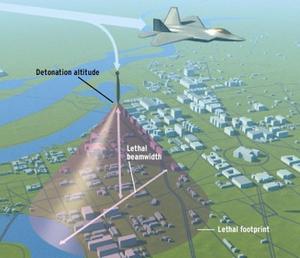How serious is the threat of an "EMP Pearl Harbor"?
In 1962 the United States conducted a high-altitude nuclear test above Johnston Island, 825 miles southwest of Hawaii; detonated 400 kilometers above the island, the resulting nuclear blast knocked out street lights across Hawaii and tripped circuit breakers, triggered burglar alarms, and damaged a telecommunications relay facility on the island of Kauai; could terrorist, or a nuclear-armed rogue state, launch an EMP Pearl harbor against the United States?

Detonated at altitude, the EMP device, knocks out electrical and electronic equipment // Source: tongilkorea.net
In what brought back some of the fears prevalent during the cold war, a scientist warned that DHS has not taken seriously the threat that high-altitude detonation of a nuclear weapon could fry the U.S. power grid. The physicist, Dr. Michael J. Frankel, warned the Judiciary Subcommittee on Terrorism and Homeland Security last week that a terrorist organization or a rogue state could detonate a nuclear weapon either above the United States or close to its shores, creating an electromagnetic pulse attack that could severely damage the country’s electronic infrastructure. Frankel is executive director of the EMP Commission, which was created in 2001 to study the national security threat an EMP attack could pose to the United States. While most of its work is classified, the commission has released two unclassified reports: one in 2004 (.pdf) and another in 2008 (.pdf).
Matthew Harwood writes that the 2008 EMP Commission report, however, expressed the threat in much stronger language. “Because of the ubiquitous dependence of U.S. society on the electrical power system, its vulnerability to an EMP attack, coupled with the EMP’s particular damage mechanisms, creates the possibility of long-term, catastrophic consequences,” the report warns, noting “[s]hould significant parts of the electrical power infrastructure be lost for any substantial period of time, the Commission believes that the consequences are likely to be catastrophic, and many people may ultimately die for lack of the basic elements necessary to sustain life in dense urban and suburban communities.”
The effects of an EMP event is not theoretical, Frankel said. In 1962 the United States conducted a high-altitude nuclear test above Johnston Island, 825 miles southwest of Hawaii. Detonated 400 kilometers above the island, the resulting nuclear blast knocked out street lights across Hawaii and tripped circuit breakers, triggered burglar alarms, and damaged a telecommunications relay facility on the island of Kauai.
Harwood notes that some national security experts and analysts have used the commission’s reports to argue Iran could use an EMP attack if it successfully acquires a nuclear bomb. “[I]f the Iranians were to detonate even a primitive nuclear warhead over
